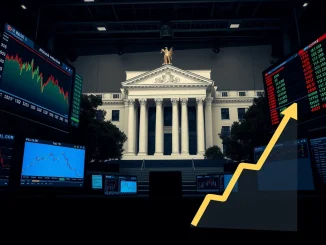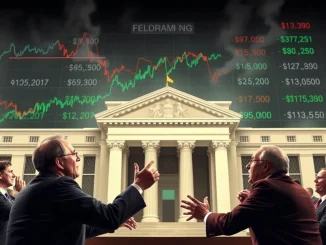
Why should investors, especially those in the dynamic world of cryptocurrencies, pay attention to reports from the U.S. Federal Reserve? Because macroeconomic signals are crucial barometers for the entire financial landscape. The latest Fed Beige Book, a snapshot of economic conditions across the Fed’s twelve regions, offers vital insights into the health and potential headwinds facing the US economy. And this time, a significant concern stands out: uncertainty surrounding trade policy.
What Did the Latest Fed Beige Book Reveal?
The Federal Reserve’s Beige Book provides a qualitative assessment of the economy, gathering anecdotal information from business contacts across the country. The recent report indicated that overall economic activity remained stable across most districts. However, beneath this surface stability, there were concerning signs.
Key findings from the report included:
- Stable Activity: On balance, the economy was reported as stable or experiencing modest growth in most regions.
- Deteriorating Outlook: Despite current stability, the outlook for several districts reportedly deteriorated sharply.
- Employment: The labor market continued to recover, with employment generally improving.
- Prices: Price levels were described as growing at a moderate or flat rate, suggesting inflation remained relatively contained at the time.
The report paints a picture of an economy holding steady in the present but facing increased apprehension about the future. The primary driver behind this darkening outlook? Uncertainty.
The Shadow of Trade Policy Uncertainty
The Beige Book explicitly highlighted Trade Policy Uncertainty as a significant factor weighing on business sentiment. This isn’t just abstract economic jargon; it has tangible impacts on how businesses operate and plan.
The report reflected on some of the initial impact of recent tariff measures, noting that uncertainty surrounding International Trade Policy exists. This uncertainty creates several challenges for businesses:
- Investment Decisions: Companies become hesitant to make large, long-term investments in new equipment, facilities, or expansion when they are unsure about future trade costs or market access.
- Supply Chains: Businesses relying on international suppliers or markets face disruptions and increased costs, leading them to potentially delay orders or seek alternative, possibly more expensive, sources.
- Pricing Strategy: Unpredictable tariff changes make it difficult for businesses to set prices for their goods and services.
This lack of clarity makes planning difficult and often leads to a more cautious, risk-averse approach from businesses, which can slow down economic momentum.
How Does Economic Uncertainty Impact the US Economy?
The Economic Uncertainty Impact isn’t confined to just the businesses directly involved in international trade. It can ripple throughout the entire US economy.
When businesses delay investment or hiring due to uncertainty, it can:
- Slow down job growth.
- Reduce capital expenditure, which is a key driver of productivity and future growth.
- Potentially dampen consumer confidence if job security concerns rise.
- Affect different sectors unevenly, with manufacturing and agriculture often being more directly exposed to trade tensions than services.
While the Beige Book noted stable conditions currently, the emphasis on deteriorating outlooks in some regions underscores how quickly sentiment can shift when faced with significant unknowns like trade policy.
Understanding the US Economic Outlook Through the Fed’s Lens
The Beige Book serves as a crucial piece of the puzzle for understanding the current US Economic Outlook. It provides ground-level insights that complement official statistics. The fact that regional contacts are reporting stable conditions but increasing pessimism about the future due to external policy factors is a signal that policymakers and investors need to heed.
It highlights the delicate balance of the economy and how non-monetary policy factors, such as International Trade Policy, can significantly influence the economic trajectory. For those in the crypto space, while digital assets often operate independently of traditional financial infrastructure, their value and adoption are still influenced by the broader economic climate and investor sentiment. A weakening traditional economy or increased risk aversion driven by uncertainty can certainly have flow-on effects.
Conclusion: Why This Matters
The latest Fed Beige Book delivers a clear message: while the US economy shows signs of current stability, the increasing Trade Policy Uncertainty is a significant headwind causing the outlook to deteriorate in some regions. This Economic Uncertainty Impact has tangible effects on business decisions, potentially slowing investment and hiring.
For anyone tracking financial markets, including cryptocurrencies, understanding these macroeconomic signals is vital. The Beige Book reminds us that global and International Trade Policy developments are not isolated events; they have real consequences for the domestic economy and contribute to the overall climate of confidence or apprehension that shapes market behavior. Staying informed on reports like the Beige Book helps paint a more complete picture of the economic environment we are navigating.



